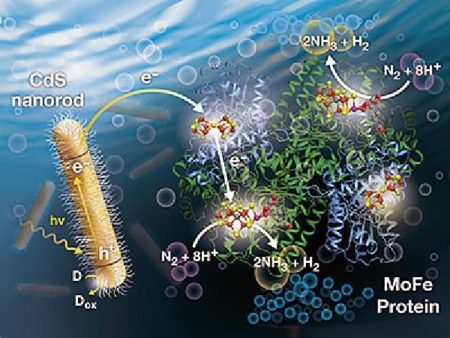Apr
26
Light Energy Used to Produce Nitrogen Fertilizer
April 26, 2016 | Leave a Comment
All living things require nitrogen for survival, but the world depends on only two known processes to break nitrogen’s ultra-strong bonds to allow conversion to a form humans, animals and plants can consume. One is a natural, bacterial process on which farmers have relied since the dawn of agriculture. The other is the century-old Haber-Bösch process, which revolutionized fertilizer production and spurred unprecedented growth of the global food supply.
Utah State University biochemist Lance Seefeldt points out, “We live in a sea of nitrogen, yet our bodies can’t access it from the air. Instead, we get this life-sustaining compound from protein in our food.”
Now Seefeldt and his colleagues have announced a light-driven process that could, once again, revolutionize agriculture, while reducing the world food supply’s dependence on fossil fuels and taking out some of the Haber-Bösch’s vast use of natural gas.

An illustration of a light-driven process for converting nitrogen to ammonia described by USU biochemists and collaborators. Image Credit: Al Hicks, NREL. Click image for the largest view.
The research team, which includes USU’s Seefeldt, Derek Harris, Andrew Rasmussen and Nimesh Khadka; Katherine A. Brown and Paul W. King of Colorado’s National Renewable Energy Laboratory; Molly Wilker, Hayden Hamby and Gordana Dukovic of the University of Colorado and Stephen Keable and John Peters of Montana State University.
The team published their findings in the April 22, 2016 issue of the journal Science.
Seefeldt, a professor in USU’s Department of Chemistry and Biochemistry and an American Association for the Advancement of Science Fellow said, “Our research demonstrates photochemical energy can replace adenosine triphosphate, which is typically used to convert dinitrogen, the form of nitrogen found in the air, to ammonia, a main ingredient of commercially produced fertilizers.”
Any way you slice it, he said, nitrogen fixation is an energy-intensive process.
“The Haber-Bösch process currently consumes about two percent of the world’s fossil fuel supply,” Seefeldt said. “So, the new process, which uses nanomaterials to capture light energy, could be a game-changer.”
NREL research scientist Katherine A. Brown explained, “Using light directly to create a catalyst is much more energy efficient. This new ammonia-producing process is the first example of how light energy can be directly coupled to dinitrogen reduction, meaning sunlight or artificial light can power the reaction.”
The research adds to the knowledge base of energy-efficient production of ammonia holding promise not only for food production, but also for development of technologies that enable use of environmentally cleaner alternative fuels, including improved fuel cells to store solar energy.
In addition to its practical applications, the research sheds light on fundamental aspects of how bacterial enzymes known as nitrogenases function; an area of chemistry Seefeldt has studied for nearly two decades.
Plant biology and food and fuel producing agriculture are directly coupled to ammonia based nitrogen for food and fuels. Worldwide the cracking of natural gas to acquire the hydrogen for ammonia and for process heat is a substantial load on the natural gas supply. Little is projected on the human starvation effects if the environmentalist crowd were to succeed in limiting natural gas supplies.
This team’s work is a breakthrough. A new field has opened up. Congratulations. But, there is still much to do.

